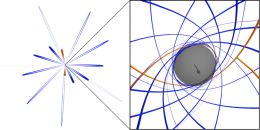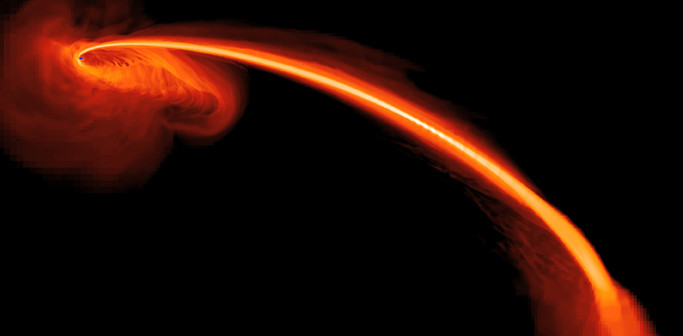In a tidal disruption event (TDE), an unfortunate star passes too close to a dormant supermassive black hole (BH) and gets torn apart by tidal forces, feeding the BH for a short time. Oddly, we’re not finding nearly as many TDEs — typically detected due to their distinctive observational signatures — as theory says we should. A recent study suggests that we might be missing many of these events, due to the way the streams of shredded stars fall onto the BHs.
Signatures of Shredding
When a BH tears a star apart, the star’s material is stretched out into what’s known as a tidal stream. That stream continues on a trajectory around the BH, with roughly half the material eventually falling back on the BH, whipping around it in a series of orbits. Where those orbits intersect each other, the material smashes together and circularizes, forming a disk that then accretes onto the BH.
What does a TDE look like? We don’t observe anything until after the tidal streams collide and the material begins to accrete onto the BH. At that point we observe a sudden peak in luminosity, which then gradually decreases (scaling roughly as time-5/3) as the tail end of what’s left of the star accretes and the BH’s food source eventually runs out.
So why have we only been observing about a tenth as many TDEs as theory predicts we should see? By studying the structure of tidal streams in TDEs, James Guillochon (Harvard-Smithsonian Center for Astrophysics) and Enrico Ramirez-Ruiz (UC Santa Cruz) have found a potential reason — and the culprit is general relativity.
Dark Years
The authors run a series of simulations of TDEs around black holes of varying masses and spins to see what form the resulting tidal streams take over time. They find that precession of the tidal stream due to the BH’s gravitational effects changes how the stream interacts with itself, and therefore what we observe. Some cases behave like what we expect for what’s currently considered a “typical” TDE — but some don’t.

Example from simulations of a tidal stream’s path around the black hole. Relativistic precession causes this tidal stream to wind around the black hole 13 times before it finally collides with itself. [Guillochon&Ramirez-Ruiz 2015]
Furthermore, for cases where the BH is both massive and has a spin of a ≳ 0.2, the tidal stream doesn’t collide with itself right away. Instead, it can take many windings around the BH before the first intersection. In these cases, it may potentially be years after a star gets ripped apart before the material accretes and we’re able to observe the event!
Citation
James Guillochon and Enrico Ramirez-Ruiz 2015 ApJ 809 166. doi:10.1088/0004-637X/809/2/166

